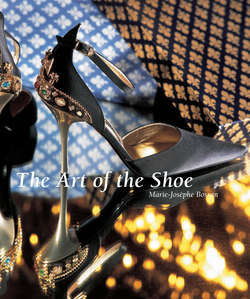Читать книгу The Art of the Shoe - Marie-Josèphe Bossan - Страница 14
На сайте Литреса книга снята с продажи.
From Antiquity up to our days
The Byzantine empire
ОглавлениеByzantine civilization extended from the 5th to the 15th century, producing throughout this period a wealth of crimson leather shoes trimmed in gold reminiscent of embroidered Persian-style boots, as well as the Roman soccus and mulleus.
Byzantine mules and slippers were objects of luxury and refinement initially reserved for the Emperor and his court. Crimson or gold slippers were worn in the eastern Mediterranean basin, in particular in the area around Alexandria and in the Nile valley. Excavations at Achmin have yielded many examples that belonged to women. The arrival of Christian shoemakers in this region revived the craft of shoemaking, as Christian symbols were added to the geometric decorative tradition. A silver sandal discovered in an Egyptian tomb and now in the collection of the Bally Museum is a good example. Dating to the 6th century AD, it is embellished with the image of a dove symbolizing Christ.
23. Stained-glass window of the baptism of Clovis by Saint-Rémy (496). Sanctuary of Saint Bonaventure, Lyon 2nd, by L. Charat and Mrs. Lamy-Paillet in 1964. Photo by J. Bonnet, Imp. Beaulieu Lyon.
24. Saint Mark Healing Aniane the Cobbler, detail from a mosaic. 13th century. Saint Mark Basilica, Venice.
